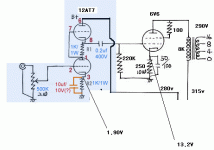Hi,
Using a mu-follower instead of the SRPP as Yves did should give you a little more gain.
Also 10 µF across 1K seems rather small. Didn't do the math though.
Cheers,
Only thing concerned is that the gain is little bit low.
Using a mu-follower instead of the SRPP as Yves did should give you a little more gain.
Also 10 µF across 1K seems rather small. Didn't do the math though.
Cheers,
Hi,
That's more like it.
What happens with too small a bypass cap is that the cathode resistor isn't bypassed for the lower frequencies.
That in turn creates some degenerative feedback reducing the gain in that band giving an impression of too little bass, or too much of a mid/high frequency boost depending on your POV.
You may have noticed that Yves left the bypass cap out altogether.
In his case it only has a minor effect on output impedance, given the already low enough Zout of the mu-follower/12AT7 combo to drive his triode I assume he didn't want to live with the drawbacks of the (usually) electrolytic bypass cap.
Cheers,
fdegrove!, how about 820ohm with 100mf
That's more like it.
What happens with too small a bypass cap is that the cathode resistor isn't bypassed for the lower frequencies.
That in turn creates some degenerative feedback reducing the gain in that band giving an impression of too little bass, or too much of a mid/high frequency boost depending on your POV.
You may have noticed that Yves left the bypass cap out altogether.
In his case it only has a minor effect on output impedance, given the already low enough Zout of the mu-follower/12AT7 combo to drive his triode I assume he didn't want to live with the drawbacks of the (usually) electrolytic bypass cap.
Cheers,
I assume he didn't want to live with the drawbacks of the (usually) electrolytic bypass cap.
(John Ford voiced) :
Yeah man, the best bypass cap is a short'd one, yeah
Yves
thanks, guys.
1.
I`ve changed 1K to 820 ohm and 10mf to 100mf of the cathode (3).
It does not sounds bumpy bass, however, smoother
and more powerful than before. Wow, is this really 6V6 SE?
2.
But I have not tried to change location of output from 12AT7.
From the plate (1) or cathode (8)? Which one is more ideal?
Can you explain its difference? (What I know is that there is impedence difference.)
1.
I`ve changed 1K to 820 ohm and 10mf to 100mf of the cathode (3).
It does not sounds bumpy bass, however, smoother
and more powerful than before. Wow, is this really 6V6 SE?
2.
But I have not tried to change location of output from 12AT7.
From the plate (1) or cathode (8)? Which one is more ideal?
Can you explain its difference? (What I know is that there is impedence difference.)
Hi,
That is !
Using the cathode as output does not add the 6V6 grid leak resistor as a load for the lower triode, more gain, more linearity, more bandwith ... better !
Yves.
Can you explain its difference? (What I know is that there is impedence difference.)
That is !
Using the cathode as output does not add the 6V6 grid leak resistor as a load for the lower triode, more gain, more linearity, more bandwith ... better !
Yves.
Hi,
That won't change the tonal balance much.
For as long as the cap is big enough so that the resistor is bypassed for the audio frequencies (say 10 hz for the lowest frequency -3dB point) then a bigger cap would only lower that corner frequency a little.
However, using too small a cap would have a filter effect subjectively boosting the mid/high frequencies.
Which is probably what you were getting used to.
If you want to find out what the amp sounds like, just remove the cap on the SRPP leaving the one on the output tube in place.
Chances are you'll like it best this way.....
If the amp still sounds too dark after that then I suspect you're listening to the the sound of the PS caps.
Having some way to measure the amp would of course settle the issue.
Cheers,
...next time i will try to add lower value of bypass cap. (50mf?)
That won't change the tonal balance much.
For as long as the cap is big enough so that the resistor is bypassed for the audio frequencies (say 10 hz for the lowest frequency -3dB point) then a bigger cap would only lower that corner frequency a little.
However, using too small a cap would have a filter effect subjectively boosting the mid/high frequencies.
Which is probably what you were getting used to.
If you want to find out what the amp sounds like, just remove the cap on the SRPP leaving the one on the output tube in place.
Chances are you'll like it best this way.....
If the amp still sounds too dark after that then I suspect you're listening to the the sound of the PS caps.
Having some way to measure the amp would of course settle the issue.
Cheers,
- Status
- This old topic is closed. If you want to reopen this topic, contact a moderator using the "Report Post" button.
- Home
- Amplifiers
- Tubes / Valves
- 6V6 Single and 12AT7 SRPP

